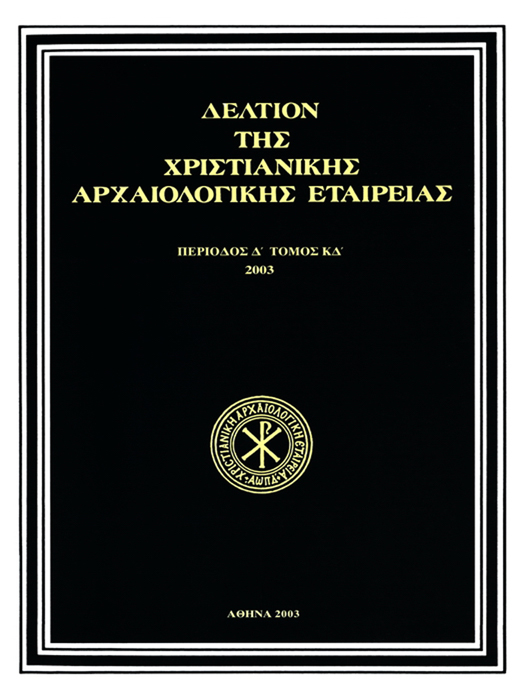The Byzantine frescoes in the church of the Taxiarches near Marcopoulo (Pl. 105-115)
Abstract
The Taxiarches near Marcopoulo in Attica, a small cruciform church, provided with a dome, preserves a fragmentary decoration of Byzantine frescoes in the Sanctuary, in the dome and on the northern part of the west arm of the cross. The painted decoration in the Sanctuary consists of a depiction of the, Virgin Kyriotissa between two worshipping angels in the conch, the Melismos flanked by four officiating bishops (SS. Nicholas, John Chrysostom, Basil and Gregory of Nyssa), below, and of a few remnants of the Ascension on the barrel vault. The only other scene of the Dodecaorton preserved is the Descent into Hell in the western vault, on the left. The best preserved decoration in the church is in the dome. This includes the Pantocrator in bust, surrounded by eight full-length prophets and four knee-length portraits of saints ; the latter are placed above the four windows of the dome. Starting from the eastern part, we see the prophets Micah and Joel, St. Cosmas, the prophets Elijah and Elisha, St. Theodote, th^ prophets Daniel and Malachi, St. Damian, the prophets Salomon and David, and St. Panteleimon. Among the iconographie peculiarities of the fresco decoration at the Taxiarches special mention may be made of the Pantocrator in the dome who does not follow the usual type known from Byzantine domed churches. His right hand does not overlap the contours of the figure but rises before his chest in blessing, in conformity with the type of the Antiphonetes. Moreover, the presence of four saints in the decoration of the dome constitutes a rare and retardataire feature, observed in very few examples of the Middle and Late Byzantine periods; this feature is often encountered in dome decorations of the Early Christian churches. The frescoes of the Taxiarches may be distinguished, from the stylistic point of view, into two groups : a) the decoration of the apse of the Sanctuary ; b) the scenes of the Ascension and of the Descent into Hell as well as the decoration of the dome. The style of the first group is more archaising as compared to that of the second group and reveals limited points of resemblance to monumental ensembles of the first half of the thirteenth century. However, certain features, especially the physiognomy of St. John Chrysostom, which lacks the spirituality of earlier saints' portraits, together with the broadness of the figure of St. Basil, may point to a dating into the latter part of the thirteenth century. As far as the frescoes of the second group are concerned, there are more clear indications for their dating towards the end of the thirteenth century. For example, the rendering of the faces of Elijah and Daniel is close to that of St. Cosmas in the church of St. George at Couneni, Crete (1284) and of the archangel Gabriel in the church of the Metamorphosis at Pyrgi, Euboea (1296). Moreover, Christ of the Descent into Hell has a powerful neck and body as well as a broad face which recall the figure of Christ of the Entry into Jerusalem in the latter church. The Byzantine frescoes of the Taxiarches near Marcopoulo may be classified among the works of a provincial and popular trend of Byzantine art in Greece, which is conventionally called monastic. However, it may be observed that the painter of the second group of frescoes, in particular, may had seen and assimilated in his own way the mosaic decoration of Daphni. The rendering of the folds and spîcific other mannerisms concerning the draperies give weight to this hypothesis.
Article Details
- How to Cite
-
ΑΣΠΡΑ-ΒΑΡΔΑΒΑΚΗ Μ. (1976). The Byzantine frescoes in the church of the Taxiarches near Marcopoulo (Pl. 105-115). Deltion of the Christian Archaeological Society, 8, 199–229. https://doi.org/10.12681/dchae.857
- Section
- Articles
The copyright for articles in the journal Deltion of the Christian Archaeological Society (henceforth Deltion) is retained by the author(s), with first publication rights granted to the journal and to EIE/ EKT the right to store and communicate these articles to the public via its information infrastructures. By virtue of their appearance in this journal, articles are free to use with proper attribution for non-commercial uses under a ShareAlike obligation. The Christian Archaeological Society and EIE/EKT retain the worldwide right to reproduce, display, distribute, and use articles published in the Deltion in all formats and media, either separately or as part of collective works for the full term of copyright. This includes but is not limited to the right to publish articles in an issue of the Journal, copy and distribute individual reprints of the articles, authorize reproduction of articles in their entirety in another publication of the Christian Archaeological Society, and authorize reproduction and distribution of articles or abstracts thereof by means of computerized retrieval systems.








